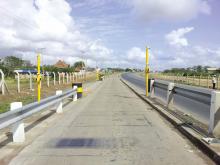
Shem Oirere looks at the beneficial effect of cargo tracking.
The mandatory installation of electronic cargo tracking and security (ECTS) systems in Kenya, Tanzania and Uganda has helped enhance revenue collection, enforce cargo handling requirements, improved the business environment of the respective countries’ trade routes and helped cargo hauliers cut costs.
This is being spearheaded by the state-owned tax collection agencies and the improved custom duty collection has not only enabled a reduction of import tax in some instances, but has also made it possible for governments to reduce tax on cargo.
Kenya Revenue Authority, Uganda Revenue Authority and Tanzania Revenue Authority have reported success in addressing illegal cargo dumping, improving security of cargo along the region’s Northern Corridor. Cargo dumping is where goods destined for, say, Uganda are illegally diverted into the Kenyan market and previously such activities have led to huge losses in tax earnings. The technology has also improved operations at the ports of Mombasa and Dar es Salaam and reinforced the agencies’ drive to automate their services.
According to
Fact File Kenya, Tanzania & Uganda
200% Increase
for ECTS installations in 2013
OVER 5,000
consignments monitored between May and September 2014 saved ...
... $252,690
in escort fees by frieght companies that installed tracking systems in their prime movers
Freight Watch highlights difficulties in collecting accurate cargo crime data because incident reporting ‘remains extremely poor throughout Africa’. Some of its information comes from the media but it said sometimes the incident is only described in general terms rather than detailing the items taken and the methods employed by the thieves.
Mandatory fitment
While technology behind ECTS became available in early 2004, it was only in April 2010 that the Kenyan government introduced the mandatory installation requirements and Uganda followed in November 2013. However some companies did preempt the legislation and in partnership with private hauliers, freight forwarders and government revenue agencies, rolled out cargo tracking technology in East Africa to help curb the thefts and minimise losses on transit cargo.
One example is Switzerland-based
“Using this technology, we are assisting Kenya’s customs processes so that trucks entering Kenyan territory are equipped with GSM/GPRS communications,” says Vincent Tibbs, governments and institutions services regional ECTS manager at SGS’s East Africa office.
Electronic seals fixed to containers are coupled with the trucks using radio frequency identification (RFID) and predefined transit corridors are configured into the system for geo-fencing purposes.
“Trucks that deviate from the predefined route are immediately identified and the customs control room notified. If the seals are tampered with or broken, an alarm is triggered, so customs can take immediate action,” said Tibbs.
An in-vehicle module (IVM) is installed into the prime mover and communicates with the seal attached to the cargo via RFID. The seal is electronically and physically sealed (known as ‘arming’). “Once armed the seal communicates with the IVM if there is an anomaly in the cargo including attempts to open the seal, cutting the seal or removal of the container from the prime mover/truck,” says Tibbs.
“All the above alerts would then be sent by the IVM to the monitoring platform and trigger an automated email,” he said.
According to Tibbs, additional alerts include confirmation that the seal is armed, notification when the seal is disarmed, departure from the origin and arrival at the destination. It will also notify excessive dwell time at a particular location, any deviation of the vehicle/cargo from the predetermined route, tampering of the IVM and disconnection of the vehicle battery (the IVM has an internal power source lasting at least 48hrs). The email alerts are sent to SGS, Kenya Revenue Authority and the company contracting the ECTS services.
“In addition, the SGS control room would call the client directly and liaise with the Kenya Revenue Authority and police in instances where the cargo has deviated from its approved route or the seal is being tampered with,” said Tibbs.
He said since December 2013 SGS has seen the number of installations for ECTS increase by 200%. This is mainly because of the requirements of the revenue authorities in East Africa and the realisation by reputable and large hauliers and freight forwarding companies of the facility to track their cargo and the benefits of doing so.
Thwarting crime
Although he could not give the total number of cargo crime cases thwarted with the introduction of the tracking system, Tibbs cited a few examples of how the tracking system saved loss of goods on transit especially on the crime prone Nairobi-Nakuru highway. For example, on 1 September 2014, a cargo vehicle was attacked by armed highway robbers at Mai Mahiu on the Nairobi-Nakuru highway. Luckily, the driver and his turn boy (driver’s mate/assistant) managed to escape. SGS’ Control Room engaged officers from the Kenya Revenue Authority and police’s Naivasha Highway Patrol Unit who quickly deployed security officers to the crime scene to secure the cargo which was later confirmed as remaining intact.
In Uganda the practice was for the owners of transit goods to employ escorts as a way of deterring criminals and other attackers – a practice which had increased the cost of some goods before the introduction of the tracking systems. Analysis by Uganda’s Revenue Authority on the effect of the introduction of a tracking system supplied by Malaysia’s Bsmart Technologies has revealed a drastic reduction in cargo escorts and the associated fees.
Between May and September 2014, there were 5,151 consignments monitored by the Uganda Revenue Authority in which an estimated $252,690 was saved in escort fees by freight companies that installed tracking systems in their prime movers.
Before the introduction of the tracking technology, it was observed for example that 200 consignments cost US$9,370 per day for physical escort. The consignments cost another US$73,500 for two days in container/truck retention and another US$7,207 in parking fees for the two days. The trucking companies were spending an average of US$90,000 a month on these costs.
“The tracking technology has removed the need for physical escorts,” said Joseph Mwangala, project manager for the Customs Business Systems Enhancement Project at the Uganda Revenue Authority. “The system monitors goods which have been armed with the eseal/etrack 24/7 and we have officers stationed in the Central Monitoring Centre to monitor the movement of those cargoes.”
He says because the system provides real-time information “it is able to tell that a truck has stopped, or is moving and at what speed and the location.”
Mwangala said unlike in some developed countries, there are no official truck stop areas on transit on the Northern Corridor which creates the persisting issue of unscheduled stops.
“The driver can stop anywhere if necessary because there are not gazetted stop points but we keep monitoring him and if we find that there are too many stops then we get in touch with him and direct him to drive to the cargo’s point of destination,” he said.
Mwangala said the electronic tracking system has helped foil the thefts of cargo in transit. “In one incident, a well-planned attack on a truck ferrying cargo from Kampala to South Sudan was averted because the vehicle was being monitored. No sooner had the attackers struck than messages were sent to the control monitoring centre in Kampala. The attackers had waited for the truck to reach a steep stretch of the highway where they planned to open the sealed doors and steal the cargo.”
He said the driver was alerted of the tampering with the doors and stopped, forcing the attackers to flee.
Although cargo owners have supported the introduction of the tracking system in the region, transporters have expressed concern at the cost of the technology.
“The installation cost of the device is US$1,050, the monthly subscription is US$45 and each electronic seal costs US$40,” said Kenya Transporters Association chairman Paul Maiyo.
The association wants more companies licenced to issue the electronic tracking system to encourage competition and bring down costs.











